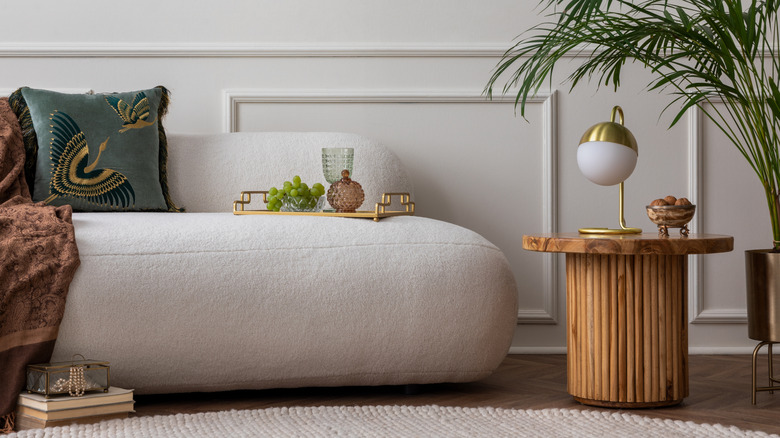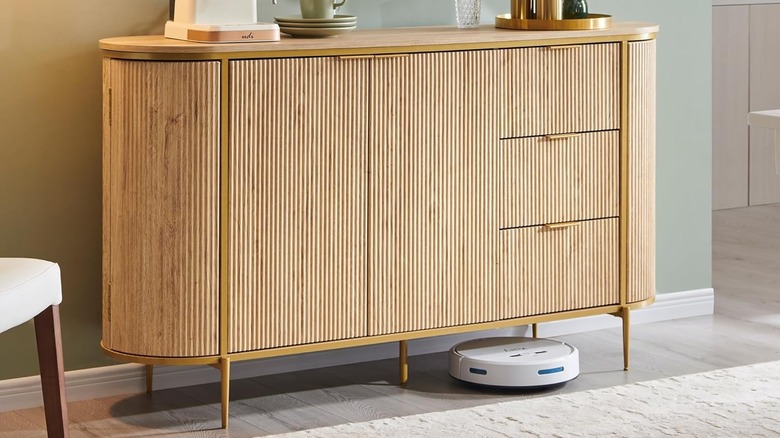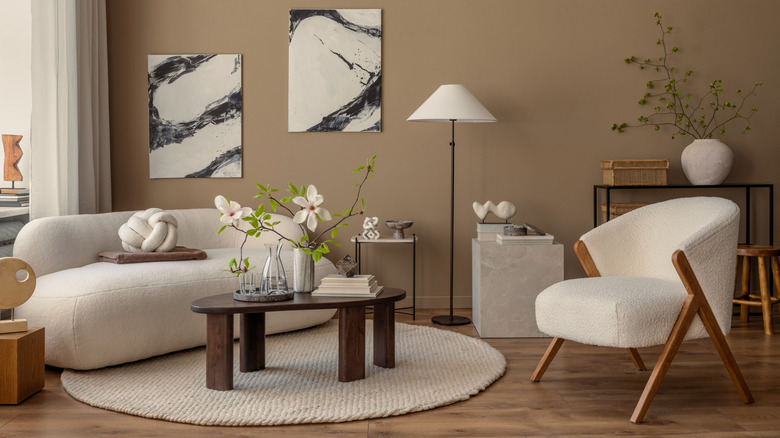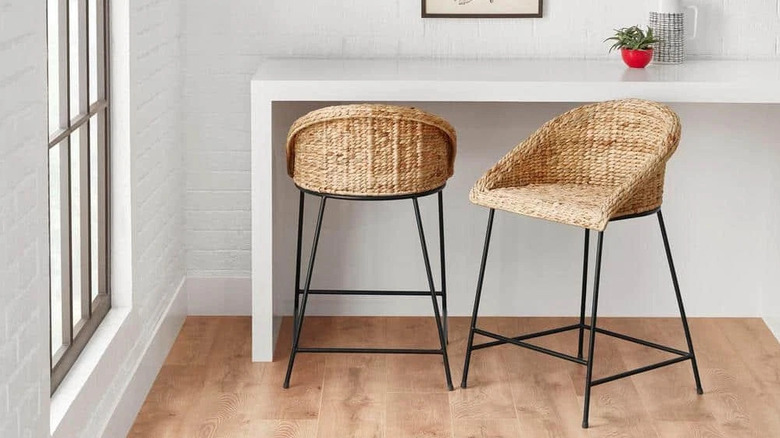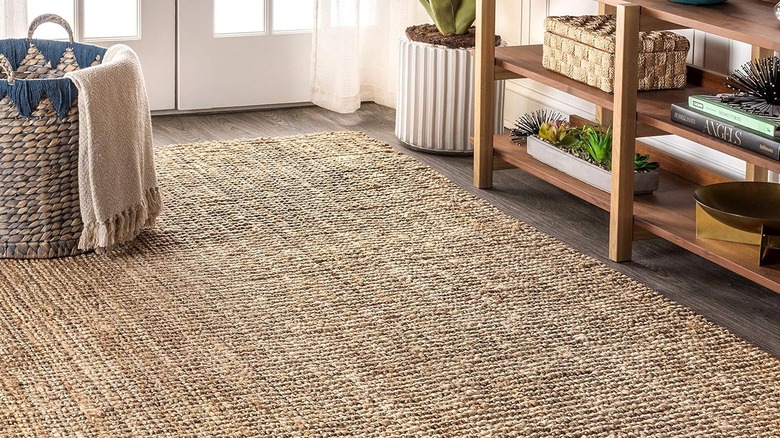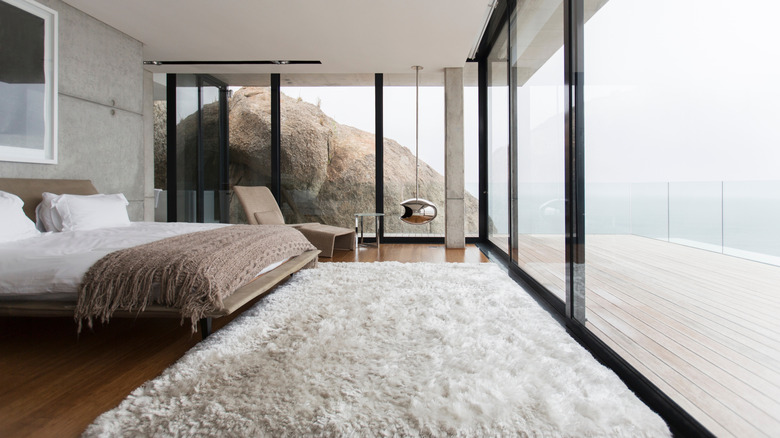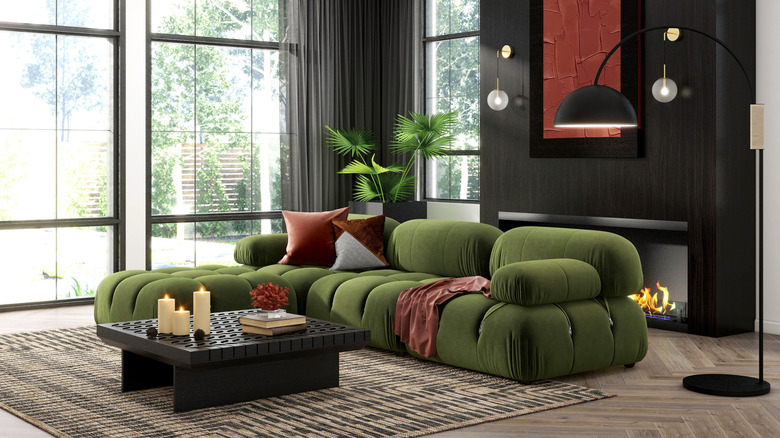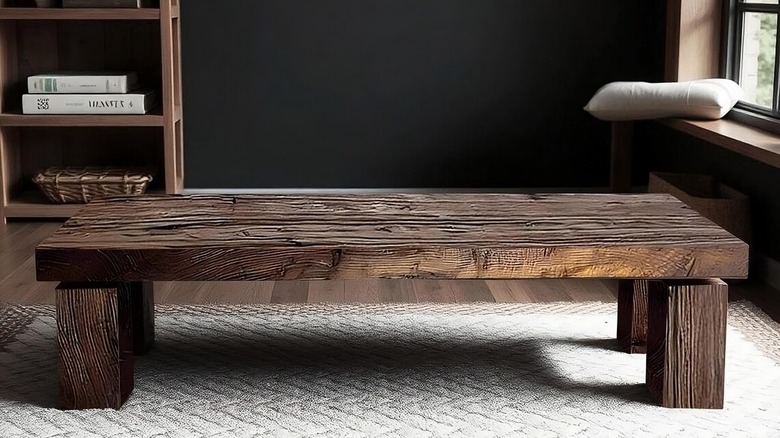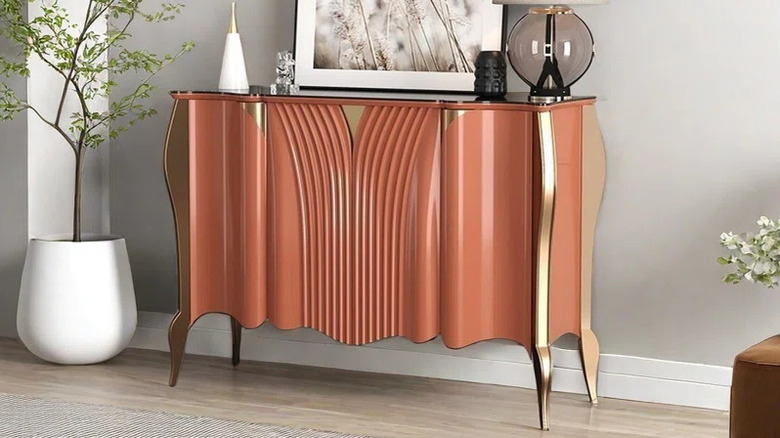Trendy Furniture Materials That Make Cleaning Way Harder Than It Needs To Be
This is the year of cozy, sustainable, and one-of-a-kind interiors as decades-old, once-trendy furniture is coming back in style. Furniture with unique textures and rich colors continues to dominate the interior design industry, and many of these pieces are made with organic and natural materials. Comfort and individuality have superseded minimalism, creating more interesting rooms. On the downside, many of these textured materials require specific caretaking to keep them in good shape.
Below are 10 trendy furniture materials that create a gorgeous statement in homes, but also make cleaning harder than it needs to be. In low-traffic homes with few household members and no pets, cleaning may not be so difficult. However, if you have multiple roommates, children, or pets, many of these furniture pieces may be more trouble than they're worth. If you don't have the time to dedicate to carefully cleaning these pieces, we have some suggestions on what to swap them for instead. Read on to learn about trends that require special and regular upkeep, why they're so high maintenance, how to clean them, and potential alternative designs you can use instead.
The grooves in fluted wood furniture need to be carefully dusted to remove all debris
Fluted wood furniture is a textured design trend that's taking over in 2025. It adds texture to a space without overwhelming it and is commonly seen in Art Deco and vintage-style interior designs. Despite its subtle and simple beauty, this carved wood style is far more tedious to clean than flat-paneled wood designs. The crevices accumulate dust, especially if the lines are horizontal. Instead of doing a once-over with a soft microfiber cloth and dusting spray, it may be more difficult to dislodge the dust trapped deep in these places.
You may need to invest in a special brush or tool, like a narrow vacuum attachment or the AURUZA Retractable Gap Dust Tool. If you're torn between your love for fluted carpentry and your desire to reduce your cleaning regimen, opt for vertical fluted cabinetry. The vertical lines still catch dust, but not as easily as horizontal ones. Seeing as curved furniture is also in, you could choose a half-rounded fluted finish, eliminating the 90-degree hard-to-reach crevice corners seen in straight furniture designs.
Boucle sofas and chairs have a unique weave that requires gentle and precise upkeep
Interior design trends are turning away from the sterile, minimalist aesthetic and leaning towards features that prioritize home comfort. Loopy woven fibers like boucle are highly desired for their depth and cozy appeal, and they're commonly incorporated in curved couches, sectionals, sofas, and poufs. Although boucle has a fuzzy look that adds a sense of hominess, it isn't as practical or durable as flat and evenly woven fabrics. The disparity in yarn sizes and shapes makes it prone to catching dust, crumbs, and pet hair.
Use a soft bristle brush, like the TriNova Upholstery Brush, to gently sweep debris off your sofa. Some people recommend using a vacuum with an upholstery attachment, but you may not want to take the risk if your vacuum has too powerful a suction. If you have stains, put a gentle laundry detergent in a spray bottle to spot clean as needed, but test an inconspicuous spot before you begin.
Boucle fabric isn't the only material out there with a fuzzy look to it, and there are other timeless alternatives to the boucle furniture trend. Chenille upholstery also has a thick, textured feel to it, and it holds up better in high-traffic areas, especially if it's made from polyester. Tweed and velvet are also soft and luxurious without being as loose and loopy as boucle, making them potential alternatives to consider, too.
The criss-cross strands in wicker furniture can trap dust and crumbs
Wicker furniture is recognizable by its unique woven material, which is often made from natural bamboo, willow, rattan, or a resin blend. This style is often seen in boho and coastal designs in indoor and outdoor settings. Although durable and weather-resistant, wicker furniture's major downfall is its interwoven fiber design. Unlike flat fabrics, solid wood, or metal materials, there are spaces between the wicker strands. These spaces catch fallen crumbs, dirt, and dust, especially in dining and outdoor setups.
Cleaning takes a bit more effort, and it can be tedious if debris has been building up for too long or is caught in a certain way. It's a multi-step process that starts with vacuuming or physically shaking out the debris. A vacuum attachment like a crevice tool or a soft dusting brush can help fish out loose crumbs before you wipe down the material with diluted white vinegar or a mixture of mild soap and water.
The best way to avoid the tedious cleaning associated with wicker is to choose a style that isn't tightly woven or has other features to barricade debris from the interwoven fibers. A spaced wicker furniture set like the YITAHOME 4-Piece Patio Wicker Outdoor Bistro Set has large gaps between the strands, so crumbs aren't trapped as easily. The table has a glass top, and the chairs have traditional flat cushions, which also catch most fallen debris. Another option is to only use woven materials as accents in your interior design, not as the most commonly used furniture sets. Instead of choosing rattan or wicker for your primary furniture, pick an item that will act more as decor, such as the Wickerix Krit Handmade Wicker Ottoman.
Jute rugs have a knobbly texture that's very hard to clean spills out of, and water will stain them
Chunky jute rugs are great for layering beneath other area rugs and adding texture to a room, making it easy to incorporate into 2025's rising maximalist and cozy trends. The only downside of these boho, coastal, and farmhouse-inspired rugs is that for certain households, they can be a cleaning nightmare. They trap dust, dirt, crumbs like other woven furniture, the knobbly texture (most noticeably on the basket weave styles) makes it very hard to lift sloppy spills, and they are easily stained by liquids, including plain water. That's because jute has natural tannins in it, which become released they come into contact with liquids, creating a blotchy stain. The intentionally ragged fibers also tend to shed — especially with heavy foot traffic — requiring you to vacuum a little more frequently than with other rugs.
Although natural jute rugs are gorgeous and have an unmatched bohemian appeal, you can find other rug materials with a similar vibe that are more practical. Polypropylene rugs are a synthetic alternative solution to jute rugs with the same look. They are often machine-washable (always check your individual product's wash instructions to be sure), making it easy to clean them on a routine basis or as messes occur. Cotton rugs, like the SAFAVIEH Rag Rug Collection Area Rug, can be just as beautiful as jute, and softer underfoot, while being potentially longer-lasting with easier maintenance. And finally if you're ready to drop cash on a really good rug, pure wool is naturally stain resistant.
The high pile of shaggy rugs captures all kinds of dirt and debris and requires care while vacuuming
High-pile and shaggy rugs add instant warmth and texture to a room, but they come with their fair share of problems. They catch more dirt and have more loose, flowing strands that snag and become matted, especially in high-traffic areas. They get dirty more easily in households with pets or children running around. Many high-pile rugs also can't be cleaned with a standard vacuum, as the suction could pull out the strands and damage the woven material.
It's important to know more details about a shag rug before you start cleaning. The pile height, type of fiber, and overall quality of the rug determine how you should go about maintaining it. As a rule of thumb, you first vaccum the underside of the rug before the top to help loosen any dirt stuck between its long fibers. Then, make sure to vacuum the floor to remove any of the dust and debris that shook loose. When you flip the carpet back right-side-up, run the vacuum over it on a high-pile setting, if possible. If you don't have one, it's safer to use the upholstery hose attachment, which can be a pain if you have a large rug.
Skip this rigorous cleaning process by layering rugs instead of investing in one plush material. Flat-weave, low-pile rugs are easier to clean, so make those your larger bottom layer. Then add a smaller shag rug on top, which will be easier to clean than a larger one. For instance, you can put two small shags on either side of the bed as an accent, and when they become dirty, you can simply shake them out outside. However, before choosing your floor coverings, first research expert design tips for layering rugs to ensure you don't end up with a confusing muddle of options.
Crumbs and objects get lost in the crevices of tufted and modular sofas
With comfy luxury on the rise, tufted sofa cushions have re-emerged in the interior design world. Although these living room seats are as functional as they are plush and cozy, they do have one downside: cleaning requires a bit more precision. Unlike the previous trend of flat seating, tufted sofas have divots in their cushions. These divots make great gathering places for dirt, crumbs, hair, and any other common household debris. It's harder to sweep debris off these cushions without accidentally shoveling it into their many crevices and indentations.
Cleaning these couches varies depending on the type of fabric, though you should start each routine the same: vacuuming the individual tufts. Unless you have boucle or another fabric that needs more gentle care, a vacuum with an upholstery attachment will work well for sucking out the loose debris. If dirt is somewhat packed together, a soft-bristle brush is also helpful in breaking apart the condensed pieces.
If your tufted seating ends up being too much work on a regular basis, you can always invest in furniture covers to revitalize your sofa and mask the indents. When it becomes messy, simply throw it into the washing machine to remove any dust and hair. It will cut your maintenance time in half!
Rough reclaimed wood needs to be brushed and wiped down gently
Organic materials like reclaimed wood bring the outdoors inside, accenting rooms with natural beauty. However, despite its prevalence in interior design for centuries, rough wood can be a hassle to preserve and care for in the long term. The uneven texture, natural grains, and knots create gathering spaces for dirt and dust. You also have to be mindful when using cleaning formulas, as even mild cleaners or plain water can discolor, swell, or otherwise damage the wood, especially in an unsealed state.
Clean reclaimed wood without any additional agents or chemicals whenever possible, starting with a dry microfiber cloth to sweep off any dust or debris. If there is sticky residue, try water and a microfiber cloth to start, but make sure it's just lightly damp and not sopping wet. Diluted castile or mild soap can also be used, but immediately wipe the surface down and dry it to ensure water doesn't linger.
This meticulous cleaning process is skippable if you seal the reclaimed wood. To do so, use a colorless water-based lacquer, like Sherwin-Williams CAB-Acrylic Lacquer. This water-based sealant has a clear finish, which won't take away from the natural wood grain and imperfections in your furniture piece. If you want to try a different sealant, make sure you choose one that is either matte or satin — a glossy finish will make the wood look fake rather than rough and natural. It's also just as much of a pain to clean — which leads us to our next point.
High-gloss finishes require specific cleaning and easily show dust and fingerprints
While unfinished and unsealed wood can be a hassle to clean, so can the other end of the spectrum. High-gloss surfaces make cleaning harder than necessary, but for very different reasons. The extremely reflective surfaces show every speck of dirt and every fingerprint that touches them. Over a week of household use, glossy lacquered tables, chair arms, and other decorative pieces can be covered in unsightly blotches.
They require consistent shine-ups, possibly daily, if you want to maintain the elegant and glossy aesthetic full-time. You also have to be careful not to accidentally damage this type of finish, as too much moisture can make it blister or crack. It should be treated with mineral oil about two to three times a year to preserve the shiny look. Stay loyal to one brand to avoid mixing silicone, oil, polyurethane, or other finishes. Outside of this routine polish, you should dust these surfaces with a dry rag whenever possible.
Since they're a lot of work, it's best to put these pieces into low traffic parts of the home. That way, fingerprints and large amounts of dust won't accumulate too quickly, necessitating the need to wipe them down almost every day. Places like formal living rooms, guest bedrooms, or sparsely used dining rooms are the best candidates for these pieces if you want to scale back on maintenance.
